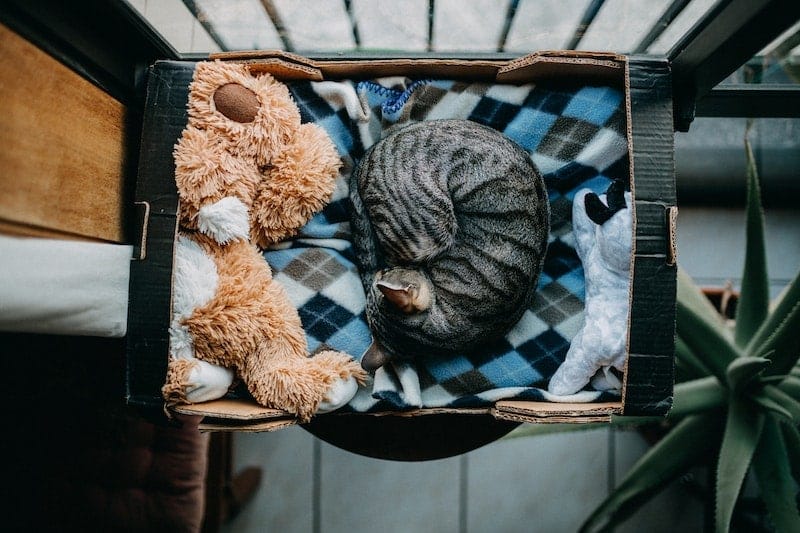Click to Skip Ahead
Cats have many cute habits, one of which is their tendency to bury their head while they sleep. Regardless of whether you’ve owned cats all your life or have only recently adopted your first feline, most cat owners are familiar with the head-burying behavior.
Though we’ll never truly know of the thought processes involved in burying their heads, we can make logical assumptions as to why cats may choose to do so. Here are eight of the most common reasons that cats bury their heads. A few of them might surprise you!
The 7 Reasons Why Cats Bury Their Heads
1. Seeking Attention
Cats aren’t often given enough credit when it comes to their intelligence. While they might not care to learn tricks like dogs, cats have street smarts to share with the world too. One of their skills is knowing exactly what makes you tick and how to get the reaction that they want out of you, including when they want attention.
The first thing that any cat owner is bound to do when their cat does something cute—like burying their head into your elbow—is coo and give them a scratch behind the ears. While you’re none the wiser and happy to bask in kitty cuddles, for the attention-seeking cat on your lap, their mission is accomplished with minimal effort on their part.
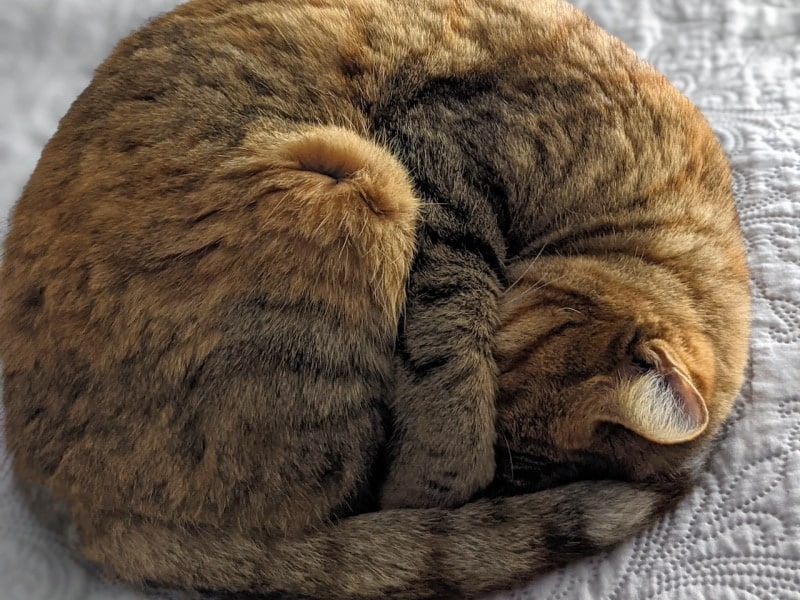
2. Comfort
Not all cats enjoy sleeping in the same way. At some point, they stretch out, curl up, or sit in a typical loaf shape, but they’ll also default to their preferred sleeping positions. Some cats will bury their heads simply because they find it comfortable.
While they’ll often bury their heads in their paws as they sleep, cats are just as likely to find comfort in burying their head against your leg, their favorite cushion, or the blanket that they’re napping on. This is much like how we too have a preference for how we sleep on our beds.
3. Grooming Session Nap
The average cat may spend up to 50% of their waking time grooming. It might be a crucial part of their routine, but it can also be a long and tiring process. If they’re grooming themselves one minute and have fallen asleep with their head buried the next, they’re perhaps satisfied with their work and are now taking a break from their spa session.
Cats spend so much time grooming themselves that falling asleep in strange positions isn’t that uncommon for them. Perhaps they were already tired after chasing a jingle ball around the house but wanted to fit in a few minutes of grooming before falling asleep. They might just be too tired to continue.
Either way, although they might look uncomfortable, your cat is likely just sleeping off their adventures so they can get up to more mischief later.
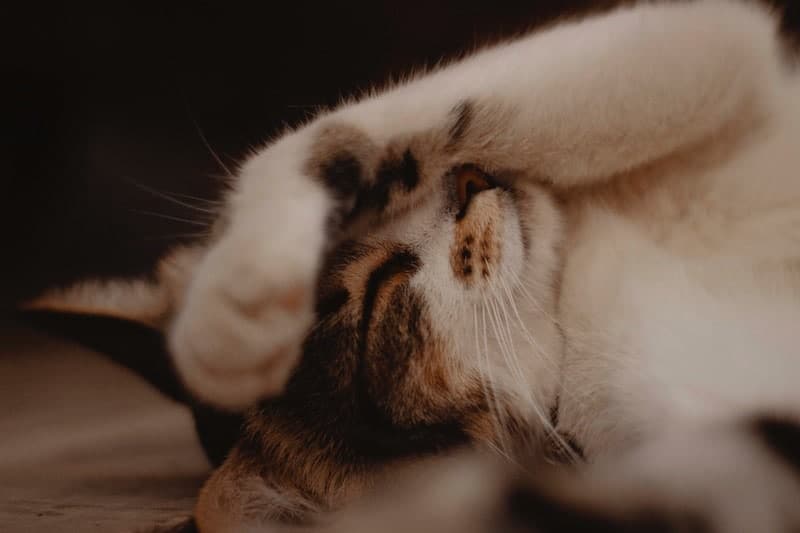
4. Marking Territory
Most of the strange behavior from cats stems from their desire to mark their territory. Burying their head into your hand while you pet them or burrowing into your arm might seem like odd, albeit cute, behavior, but it’s also a sneaky way to mark you.
Anyone familiar with cats knows that they spend a great deal of time rubbing their faces against anything and everything. Cats have scent glands on their faces and rely on scents to communicate. They use it to warn other cats about trespassing, to self-soothe, to bond with other cats and humans, and even to identify family members.
When they bury their face in your arm your cat is also rubbing their scent onto you. The next time that you encounter another cat, they’ll know that you’re off-limits.
5. Showing Affection
When they’re in the mood for attention, cats can be highly affectionate. They might not be able to vocalize their adoration for you in the same way that humans or dogs can, but they can show it in other ways. Burying their head against you doesn’t just spread their scent and mark their territory; it’s also their way of showing you affection.
Similar to how we pet them, they’ll rub their faces against you to return the favor. Burrowing their head into your side or your hand is also their way of saying “hello,” particularly if they haven’t seen you all day.
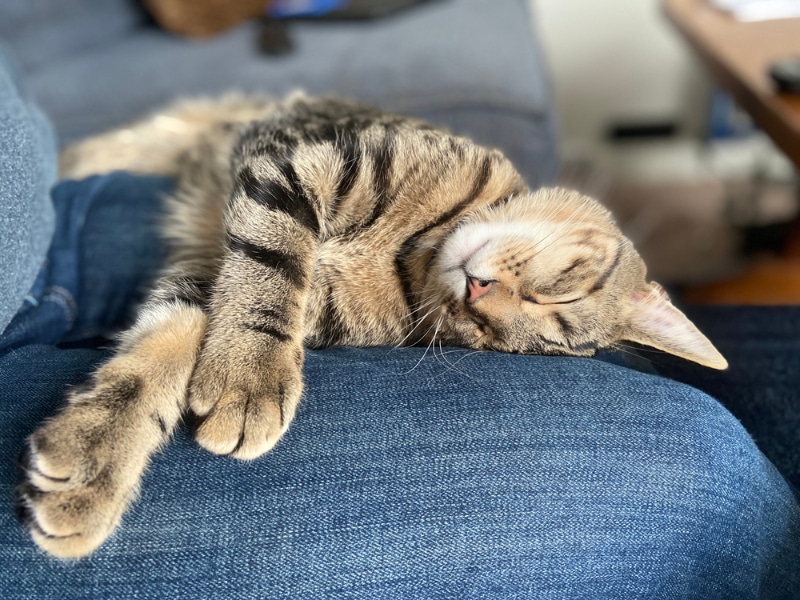
6. Too Bright
Sunny spots are warm, cozy, and the perfect place for a nap. However, they do have a downside. All the sunshine beaming in through the window might be comfortably toasty, but it can be incredibly bright. If you’ve ever tried to nap with the lights on, you’ll know how intrusive bright lights can be when you just want to sleep.
Once your cat has found the perfect spot to nap in, they’re unlikely to move for anything, including the bright sunshine keeping their cushion warm. Burying their head in their cushion, a blanket, or your arm if they’re on your lap is a way for them to stay put and block out the light. They get to enjoy the sun or your attention and still take a nap away from intrusive lights. It’s a win-win.
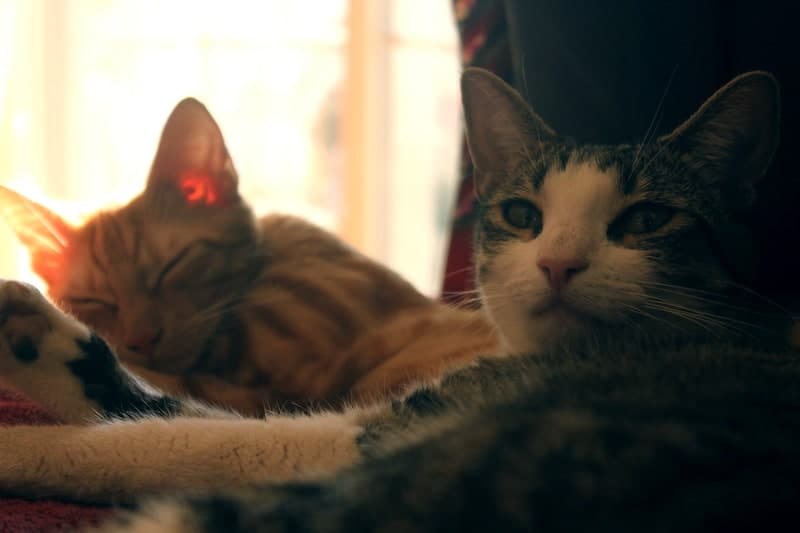
7. Warmth
The chillier it is in your home or outside, the more likely your cat is to curl up as small as possible. They’ll tuck in their paws, keep their tail close, and hide their noses. If they’re cold, your cat will be more likely to take advantage of your body warmth. While you might assume that they might only be interested in sitting on your lap, they might bury their nose into your stomach or your arm.
Curling into a tiny ball of fluff and hiding their head anywhere they can is your cat’s way of staying warm.
Why Does My Cat Bury Their Head in My Hand?
Hands aren’t always the warmest part of the body, so it can be confusing when your cat chooses to burrow into your palm instead of someplace warmer. Sometimes, sleeping with their head buried in your hand is an accident. Maybe they fell asleep while you were scratching their chin and were comfortable enough that they didn’t bother moving.
Perhaps your cat is simply taking advantage of another heat source. If your hand is on your stomach, for example, your cat might bury their head underneath your palm because they’re cold and seeking warmth from your body. This is relatively common in kittens, who aren’t that great at thermoregulation when compared to adult cats. The presence of your hand is just a good excuse to enjoy attention.
Burying their head into your hand might also be their way of saying “hi.” When you see your cat, you typically reach out with your hand to pet them. In this case, your hand is often the first thing that your cat can reach too.
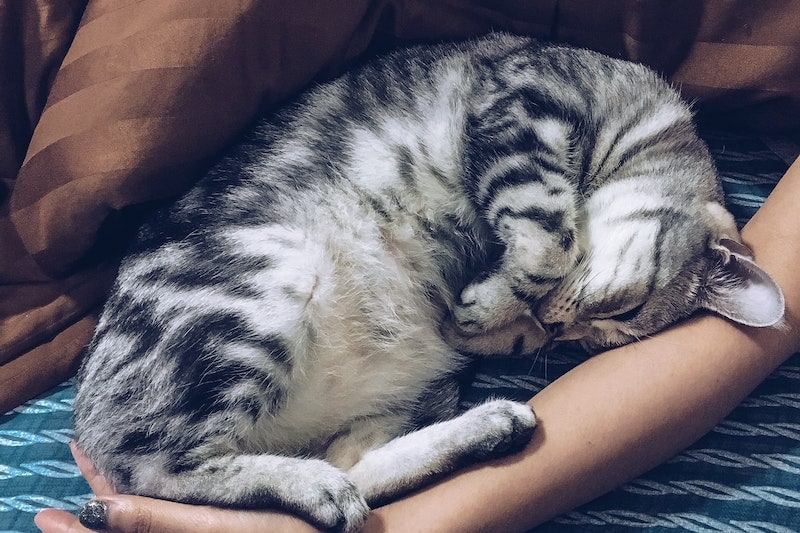
Why Does My Cat Bury Their Head in My Armpit?
Of all the places that your cat could choose to burrow into, your armpit is probably the most peculiar. As with all cat behavior, though, there is a reason that your feline has chosen your armpit as the best place to nap.
Armpits are perhaps the warmest spots on your body and carry your scent. Other humans might find it unpleasant, but cats can find comfort in the warmth and the familiarity of your scent—whether you use deodorant or not.
Burrowing into your armpit may also help skittish cats feel secure. Not only will they be protected by your arm and torso, but they also have the perfect spot to hide their heads and pretend they’re invisible. You’ll be close by to deal with any trouble that might arise, and they can nap in safety without worrying about what scared them.

Final Thoughts
Cats will often bury their heads for several reasons, such as to block out the light while they sleep, but they’ll also hide their faces if they’re cold or if they know it will get your attention. They’ll even burrow into you to seek some cuddles or mark you with their scent.
No matter their reasoning for burying their heads, we can all agree that it’s an endearing habit. At the end of a long week, having a cat show their adoration for you by burrowing their head into your side is one of the best things ever.
- See Also: Why Do Cats Fake Sleep?
Featured Image Credit: João Jesus, Pexels

